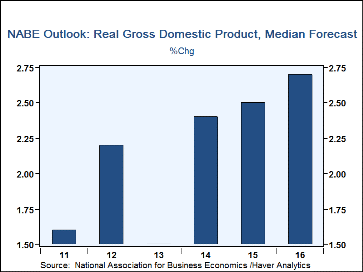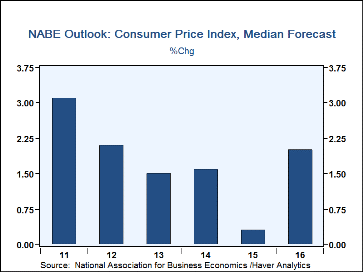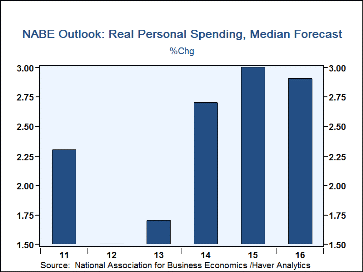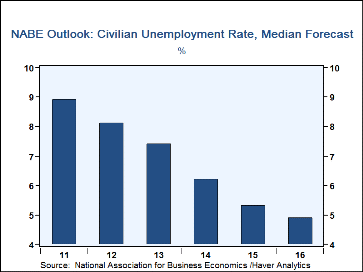 Global| Oct 12 2015
Global| Oct 12 2015NABE Lowers Real Growth and Inflation Forecasts
by:Tom Moeller
|in:Economy in Brief
Summary
The National Association for Business Economics forecast of 2.7% growth in U.S. real economic activity in 2016 was revised from 2.9% posted in June. Expected growth of 2.5% this year, however, was little-changed. Quarterly GDP growth [...]
The National Association for Business Economics forecast of 2.7% growth in U.S. real economic activity in 2016 was revised from 2.9% posted in June. Expected growth of 2.5% this year, however, was little-changed. Quarterly GDP growth is expected to range between 2.5% and 2.8%. Forecasted growth in personal consumption expenditures was unchanged at 2.9% next year following a 3.0% rise this year. These remain the strongest yearly gains since 2006. Growth expectations for business investment in equipment in 2016 were lowered to 5.0% from 5.7%. Expected growth in spending on nonresidential structures also was lessened to 4.3% following this year's slight decline. The rate of inventory investment should ease next year by more-than-expected earlier after firming this year and last. Real net exports are expected to deteriorate more than previously expected, producing a slightly larger drag on U.S. GDP growth in 2016. Forecasted improvement next year of 8.1% in residential investment was little-changed. It thus should continue to be the economy's strongest sector following an unchanged 8.5% rise this year.
Forecasts for housing starts remained unchanged for growth to 1.28 million in 2016 following a slightly raised expectation for 1.12 million starts this year. Expectations for light vehicle sales were nudged up to 17.1 million units next year, a fifteen year high, unchanged from a raised 17.1 million in 2015. Average monthly gains in payroll employment are expected to remain steady at 211,000, raised slightly from the prior estimate. Expectations for the unemployment rate were lowered to an average 4.9% in 2016 following a lessened 5.3% this year. Consumer price inflation is expected to average a slightly lessened 2.0%, the quickest rate of increase since 2011, after an unchanged forecast for a 0.3% rise this year.
The forecasted 3.00% interest rate on 10-year Treasury notes at the end of next year follows 2.40% at the end of this year. Both figures were reduced slightly from earlier expectations. The Fed is expected to begin raising interest rates this quarter, later than the earlier expectation. Corporate profits next year should rise an unrevised 4.7% following a raised forecast of 4.0% growth this year. The Federal government budget deficit is expected to shrink to $430 billion in 2016, a lower figure versus the earlier expectation and roughly one-third its $1.4 trillion peak in 2009.
The figures from the latest NABE report can be found in Haver's SURVEYS database.
U.S. Economy and Monetary Policy is the title of Fed Vice Chairman Stanley Fischer's speech and it can be found here.
| National Association For Business Economics | 2016 | 2015 | 2014 | 2013 |
|---|---|---|---|---|
| Real GDP (% Chg. SAAR) | 2.7 | 2.5 | 2.4 | 1.5 |
| Personal Consumption Expenditures | 2.9 | 3.0 | 2.7 | 1.7 |
| Nonresidential Structures | 4.3 | -0.1 | 8.1 | 1.6 |
| Nonresidential Equipment | 5.0 | 3.0 | 5.8 | 3.2 |
| Residential Investment | 8.1 | 8.5 | 1.8 | 9.5 |
| Change in Real Business Inventories (Bil. $) | 60.4 | 94.7 | 68.0 | 61.4 |
| Real Net Exports (Bil. $) | -560.0 | -536.5 | -442.5 | -417.5 |
| Housing Starts (Mil. Units) | 1.28 | 1.12 | 1.00 | 0.92 |
| Light Vehicle Sales (Mil. Units) | 17.1 | 17.1 | 16.4 | 15.5 |
| Payroll Employment Average Monthly Change (000s) | 211 | 212 | 260 | 199 |
| Unemployment Rate (%) | 4.9 | 5.3 | 6.2 | 7.4 |
| Consumer Price Index (Y/Y %) | 2.0 | 0.3 | 1.6 | 1.5 |
| Fed Funds Rate (%, Year-End) | 1.38 | 0.35 | 0.13 | 0.13 |
| 10-Year Treasury Note (%, Year-End) | 3.00 | 2.40 | 2.17 | 3.04 |
Tom Moeller
AuthorMore in Author Profile »Prior to joining Haver Analytics in 2000, Mr. Moeller worked as the Economist at Chancellor Capital Management from 1985 to 1999. There, he developed comprehensive economic forecasts and interpreted economic data for equity and fixed income portfolio managers. Also at Chancellor, Mr. Moeller worked as an equity analyst and was responsible for researching and rating companies in the economically sensitive automobile and housing industries for investment in Chancellor’s equity portfolio. Prior to joining Chancellor, Mr. Moeller was an Economist at Citibank from 1979 to 1984. He also analyzed pricing behavior in the metals industry for the Council on Wage and Price Stability in Washington, D.C. In 1999, Mr. Moeller received the award for most accurate forecast from the Forecasters' Club of New York. From 1990 to 1992 he was President of the New York Association for Business Economists. Mr. Moeller earned an M.B.A. in Finance from Fordham University, where he graduated in 1987. He holds a Bachelor of Arts in Economics from George Washington University.










